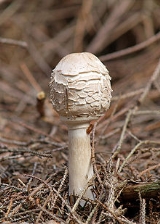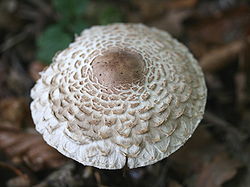
Shaggy parasol
Encyclopedia
The Shaggy parasol is the common name
for two closely related species of mushrooms, Chlorophyllum rhacodes and C. brunneum, found in North America
and Europe
(the latter species is also found in Australia
).
than to Macrolepiota procera. The subspecies Macrolepiota rhacodes var. brunneum was also elevated to species status as Chlorophyllum brunneum. Chlorophyllum olivieri is a closely related species that is also eaten as the "Shaggy Parasol."
Many older reference books spell the epithet "rachodes" rather than "rhacodes". The spelling "rachodes" was used by Vittadini
when he first published the species in 1835, but is erroneous as the Greek word rhakos 'piece of cloth' should be transcribed as rhacos.
, with thick brown scales
and protuberances on its fleshy white cap
. The gills and spore print
are both white in colour. Its stipe
is slender, but bulbous at the base, is coloured uniformly and bears no patterns. It is fleshy, and a reddish, or maroon
discoloration occurs and a pungent odour is evolved when it is cut. The egg
-shaped caps become wider and flatter as they mature.
The stem
of C. rhacodes grows to 10 to 20 cm (4 to 8 in) tall. The cap grows to 7.5 to 20 cm (3 to 8 in) across, while the stipe has a diameter
of 1 to 2 centimetres.
 The shaggy parasol is popularly praised as a choice edible mushroom
The shaggy parasol is popularly praised as a choice edible mushroom
. However, it contains toxins which can cause gastric upsets when eaten raw or undercooked, and some individuals show a strong allergic response even after cooking.
Furthermore, young shaggy parasols look identical to the poisonous Chlorophyllum molybdites
(the mushroom that causes the most poisonings in North America yearly). Checking the spore print is essential as C. molybdites' print is green (older specimens have slightly green gills). As a result, this mushroom is not recommended for inexperienced hunters.
, Macrolepiota procera. The latter grows considerably larger however, and is more likely to be found in the open than M. rhacodes which prefers more shade
and dislikes open pastures and fields
. Another distinguishing feature is that M. rhacodes lacks the brown bands that are on the stem of M. procera.
Common name
A common name of a taxon or organism is a name in general use within a community; it is often contrasted with the scientific name for the same organism...
for two closely related species of mushrooms, Chlorophyllum rhacodes and C. brunneum, found in North America
North America
North America is a continent wholly within the Northern Hemisphere and almost wholly within the Western Hemisphere. It is also considered a northern subcontinent of the Americas...
and Europe
Europe
Europe is, by convention, one of the world's seven continents. Comprising the westernmost peninsula of Eurasia, Europe is generally 'divided' from Asia to its east by the watershed divides of the Ural and Caucasus Mountains, the Ural River, the Caspian and Black Seas, and the waterways connecting...
(the latter species is also found in Australia
Australia
Australia , officially the Commonwealth of Australia, is a country in the Southern Hemisphere comprising the mainland of the Australian continent, the island of Tasmania, and numerous smaller islands in the Indian and Pacific Oceans. It is the world's sixth-largest country by total area...
).
Taxonomy
Chlorophyllum rhacodes, C. Olivieri and C. brunneum were formerly known as Macrolepiota rhacodes or Lepiota rhacodes, but the name was changed on the basis of molecular phylogenetic evidence demonstrating a closer relationship to Chlorophyllum molybditesChlorophyllum molybdites
Chlorophyllum molybdites, which has the common names of false parasol or green-spored parasol is a widespread mushroom. Highly poisonous and producing severe gastrointestinal symptoms of vomiting and diarrhea, it is commonly confused with the shaggy parasol, and is the most commonly consumed...
than to Macrolepiota procera. The subspecies Macrolepiota rhacodes var. brunneum was also elevated to species status as Chlorophyllum brunneum. Chlorophyllum olivieri is a closely related species that is also eaten as the "Shaggy Parasol."
Many older reference books spell the epithet "rachodes" rather than "rhacodes". The spelling "rachodes" was used by Vittadini
Carlo Vittadini
Carlo Vittadini was an Italian doctor and mycologist.- Life :He studied in Milan and at the University of Pavia, where he attended the classes given by Giuseppe L. Moretti...
when he first published the species in 1835, but is erroneous as the Greek word rhakos 'piece of cloth' should be transcribed as rhacos.
Description
The shaggy parasol is a large and conspicuous agaricAgaric
An agaric is a type of fungal fruiting body characterized by the presence of a pileus that is clearly differentiated from the stipe , with lamellae on the underside of the pileus. "Agaric" can also refer to a basidiomycete species characterized by an agaric-type fruiting body...
, with thick brown scales
Scale (zoology)
In most biological nomenclature, a scale is a small rigid plate that grows out of an animal's skin to provide protection. In lepidopteran species, scales are plates on the surface of the insect wing, and provide coloration...
and protuberances on its fleshy white cap
Pileus (mycology)
The pileus is the technical name for the cap, or cap-like part, of a basidiocarp or ascocarp that supports a spore-bearing surface, the hymenium. The hymenium may consist of lamellae, tubes, or teeth, on the underside of the pileus...
. The gills and spore print
Spore print
thumb|300px|right|Making a spore print of the mushroom Volvariella volvacea shown in composite: mushroom cap laid on white and dark paper; cap removed after 24 hours showing pinkish-tan spore print...
are both white in colour. Its stipe
Stipe (mycology)
thumb|150px|right|Diagram of a [[basidiomycete]] stipe with an [[annulus |annulus]] and [[volva |volva]]In mycology a stipe refers to the stem or stalk-like feature supporting the cap of a mushroom. Like all tissues of the mushroom other than the hymenium, the stipe is composed of sterile hyphal...
is slender, but bulbous at the base, is coloured uniformly and bears no patterns. It is fleshy, and a reddish, or maroon
Maroon (color)
Maroon is a dark red color.-Etymology:Maroon is derived from French marron .The first recorded use of maroon as a color name in English was in 1789.-Maroon :...
discoloration occurs and a pungent odour is evolved when it is cut. The egg
Egg (biology)
An egg is an organic vessel in which an embryo first begins to develop. In most birds, reptiles, insects, molluscs, fish, and monotremes, an egg is the zygote, resulting from fertilization of the ovum, which is expelled from the body and permitted to develop outside the body until the developing...
-shaped caps become wider and flatter as they mature.
The stem
Stipe (mycology)
thumb|150px|right|Diagram of a [[basidiomycete]] stipe with an [[annulus |annulus]] and [[volva |volva]]In mycology a stipe refers to the stem or stalk-like feature supporting the cap of a mushroom. Like all tissues of the mushroom other than the hymenium, the stipe is composed of sterile hyphal...
of C. rhacodes grows to 10 to 20 cm (4 to 8 in) tall. The cap grows to 7.5 to 20 cm (3 to 8 in) across, while the stipe has a diameter
Diameter
In geometry, a diameter of a circle is any straight line segment that passes through the center of the circle and whose endpoints are on the circle. The diameters are the longest chords of the circle...
of 1 to 2 centimetres.
Edibility

Edible mushroom
Edible mushrooms are the fleshy and edible fruiting bodies of several species of fungi. Mushrooms belong to the macrofungi, because their fruiting structures are large enough to be seen with the naked eye. They can appear either below ground or above ground where they may be picked by hand...
. However, it contains toxins which can cause gastric upsets when eaten raw or undercooked, and some individuals show a strong allergic response even after cooking.
Furthermore, young shaggy parasols look identical to the poisonous Chlorophyllum molybdites
Chlorophyllum molybdites
Chlorophyllum molybdites, which has the common names of false parasol or green-spored parasol is a widespread mushroom. Highly poisonous and producing severe gastrointestinal symptoms of vomiting and diarrhea, it is commonly confused with the shaggy parasol, and is the most commonly consumed...
(the mushroom that causes the most poisonings in North America yearly). Checking the spore print is essential as C. molybdites' print is green (older specimens have slightly green gills). As a result, this mushroom is not recommended for inexperienced hunters.
Similar species
The shaggy parasol is similar in appearance to the similarly edible parasol mushroomParasol mushroom
The parasol mushroom is a basidiomycete fungus with a large, prominent fruiting body resembling a lady's parasol. It is a fairly common species on well-drained soils. It is found solitary or in groups and fairy rings in pastures and occasionally in woodland...
, Macrolepiota procera. The latter grows considerably larger however, and is more likely to be found in the open than M. rhacodes which prefers more shade
Shade
Shade is the blocking of sunlight by any object, and also the shadow created by that object. Shade also consists of the colors grey, black, white, etc...
and dislikes open pastures and fields
Field (agriculture)
In agriculture, the word field refers generally to an area of land enclosed or otherwise and used for agricultural purposes such as:* Cultivating crops* Usage as a paddock or, generally, an enclosure of livestock...
. Another distinguishing feature is that M. rhacodes lacks the brown bands that are on the stem of M. procera.

